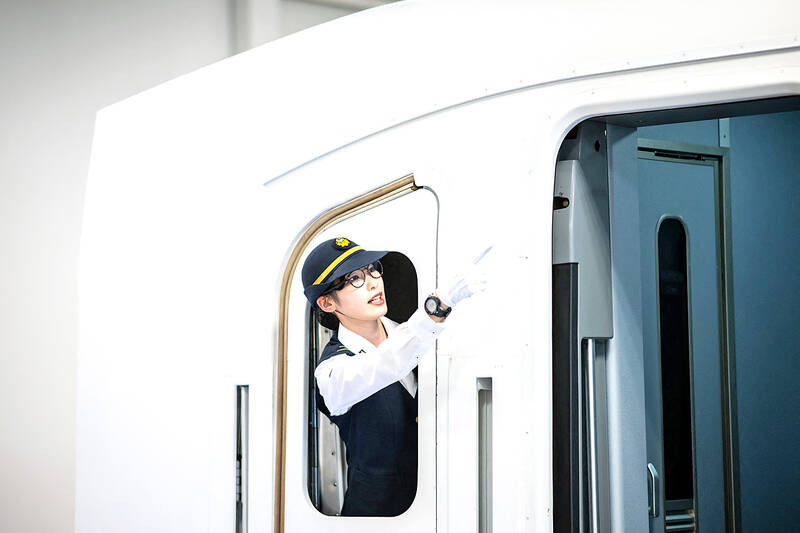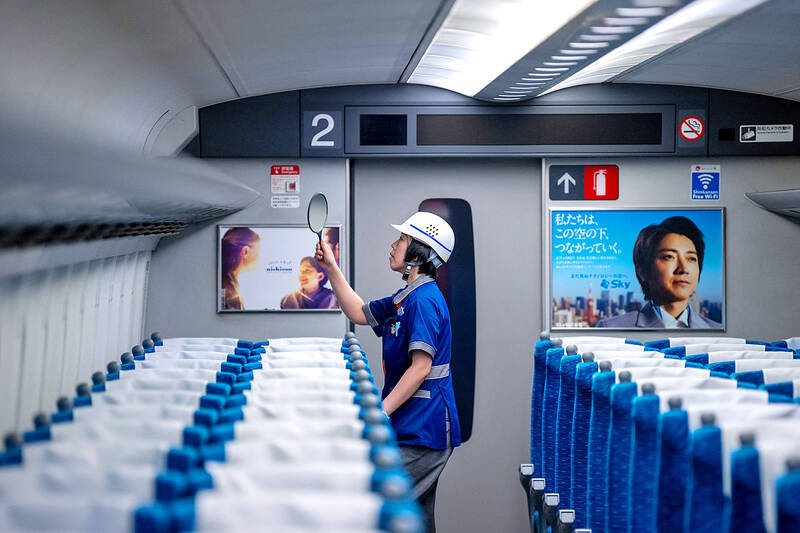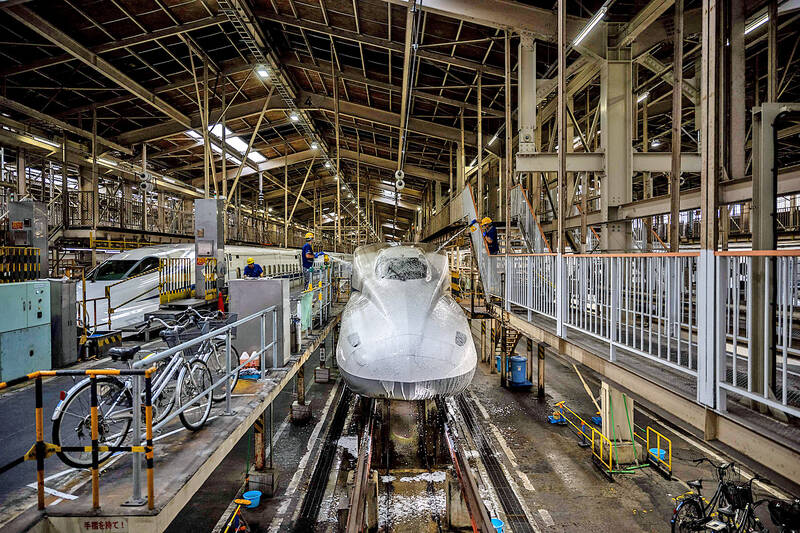Her white-gloved, waistcoated uniform impeccable, 22-year-old Hazuki Okuno boards a bullet train replica to rehearse the strict protocols behind the smooth operation of a Japanese institution turning 60 Tuesday.
High-speed Shinkansen trains began running between Tokyo and Osaka on Oct. 1, 1964, heralding a new era for rail travel as Japan grew into an economic superpower after World War II.
The service remains integral to the nation’s economy and way of life — so keeping it dazzlingly clean, punctual and accident-free is a serious job.

Photo: AFP
At a 10-story, state-of-the-art staff training center, Okuno shouted from the window and signaled to imaginary colleagues, keeping her cool when a video screen down the platform showed a flailing passenger stuck in a door.
The live-in facility southwest of Tokyo offers what rail operator Central Japan Railway Co (JR Central) describes as an “intense education” for future conductors, drivers and other team members.
“Thank you for riding,” Okuno practiced saying, bowing deeply after checking the time on her watch.

Photo: AFP
Each day nearly one-quarter of a million passengers ride the Tokaido Shinkansen line, which stretches from Tokyo past Mount Fuji to Hakata, about five hours away.
One top-speed Nozomi train arrives up to every five minutes.
JR Central said it has never had an accident resulting in death or injury on the bullet train, even in a country where earthquakes, typhoons and heavy snow are common.

Photo: AFP
Safety is “our top priority,” JR Central public relations officer Daisuke Kumajima said. So “we take our education and training of our employees very seriously.”
This month for the first time, on another line run by East Japan Railway Co (JR East), two linked bullet trains uncoupled, resulting in an emergency stop, but no injuries.
With routes spanning the country, the Shinkansen’s top speed of 320kph is no longer the world’s fastest, having been outpaced by China.
However, the original high-speed locomotive’s streamlined nose and spacious interiors remain a symbol of Japanese engineering prowess and attention to detail.
It is also a tourist must-do and pop culture mainstay — such as in Brad Pitt’s 2022 blockbuster Bullet Train.
A meticulous maintenance schedule means the trains are gleaming outside and in, with cleaners adjusting headrests and using brushes to ensure the seats are free of crumbs.
In some countries, train delays leave little time for such primping, said Christopher Hood, author of the book Shinkansen: From Bullet Train to Symbol of Modern Japan.
On the bullet train network, the average delay is less than a minute.
The growth of cities along Shinkansen routes over the decades shows its effect on the economy in Japan, where “face-to-face business is very, very important,” added Hood, a researcher at Cardiff University in Wales.
In tandem, the train has played a role in speeding up depopulation in rural Japan, leaving many elderly people isolated, Hood said.
“People would rather live in the big cities ... and then use the Shinkansen to go and visit relatives out in smaller cities if they need to,” he said.
At a JR Central site, an engineer taps the inner machinery of a bullet train, listening closely for any unusual sounds that could reveal a loose part.
With aging Japan increasingly facing labor shortages, the company is also researching a new digital inspection system that can analyze images of a train to spot dangers.
Meanwhile, JR East has said that driverless bullet trains could be introduced from the mid-2030s.
There is also a huge project under way to build a high-speed magnetic levitation (maglev) line in Japan, long-delayed due to environmental opposition.
Maglev trains, which can run at 500kph, were meant to begin service between Tokyo and Nagoya in central Japan in 2027, but JR Central has pushed that back to 2034 or later.
The aim is to create a “dual system” with the Shinkansen to respond to demand and keep operations stable in the case of maintenance work or a major earthquake, Kumajima said.
It is easy to take the Shinkansen for granted in Japan, which is a good thing, Hood said.
However, when Japanese travel overseas, particularly in Europe or the US, “they soon appreciate that ‘yeah, the Shinkansen is a little bit special,’” he said.

The US dollar was trading at NT$29.7 at 10am today on the Taipei Foreign Exchange, as the New Taiwan dollar gained NT$1.364 from the previous close last week. The NT dollar continued to rise today, after surging 3.07 percent on Friday. After opening at NT$30.91, the NT dollar gained more than NT$1 in just 15 minutes, briefly passing the NT$30 mark. Before the US Department of the Treasury's semi-annual currency report came out, expectations that the NT dollar would keep rising were already building. The NT dollar on Friday closed at NT$31.064, up by NT$0.953 — a 3.07 percent single-day gain. Today,

‘SHORT TERM’: The local currency would likely remain strong in the near term, driven by anticipated US trade pressure, capital inflows and expectations of a US Fed rate cut The US dollar is expected to fall below NT$30 in the near term, as traders anticipate increased pressure from Washington for Taiwan to allow the New Taiwan dollar to appreciate, Cathay United Bank (國泰世華銀行) chief economist Lin Chi-chao (林啟超) said. Following a sharp drop in the greenback against the NT dollar on Friday, Lin told the Central News Agency that the local currency is likely to remain strong in the short term, driven in part by market psychology surrounding anticipated US policy pressure. On Friday, the US dollar fell NT$0.953, or 3.07 percent, closing at NT$31.064 — its lowest level since Jan.

The New Taiwan dollar and Taiwanese stocks surged on signs that trade tensions between the world’s top two economies might start easing and as US tech earnings boosted the outlook of the nation’s semiconductor exports. The NT dollar strengthened as much as 3.8 percent versus the US dollar to 30.815, the biggest intraday gain since January 2011, closing at NT$31.064. The benchmark TAIEX jumped 2.73 percent to outperform the region’s equity gauges. Outlook for global trade improved after China said it is assessing possible trade talks with the US, providing a boost for the nation’s currency and shares. As the NT dollar

The Financial Supervisory Commission (FSC) yesterday met with some of the nation’s largest insurance companies as a skyrocketing New Taiwan dollar piles pressure on their hundreds of billions of dollars in US bond investments. The commission has asked some life insurance firms, among the biggest Asian holders of US debt, to discuss how the rapidly strengthening NT dollar has impacted their operations, people familiar with the matter said. The meeting took place as the NT dollar jumped as much as 5 percent yesterday, its biggest intraday gain in more than three decades. The local currency surged as exporters rushed to